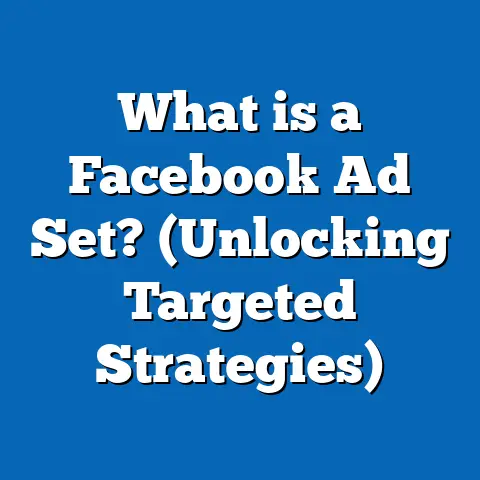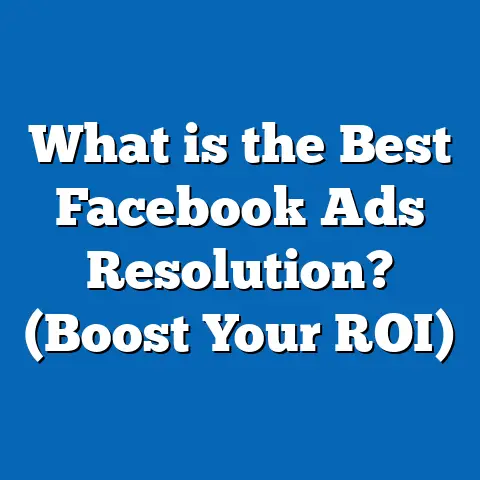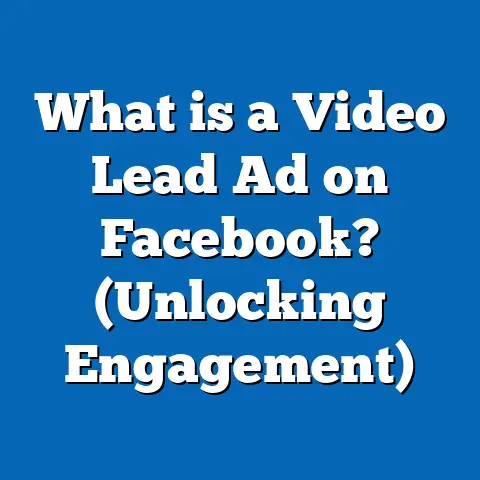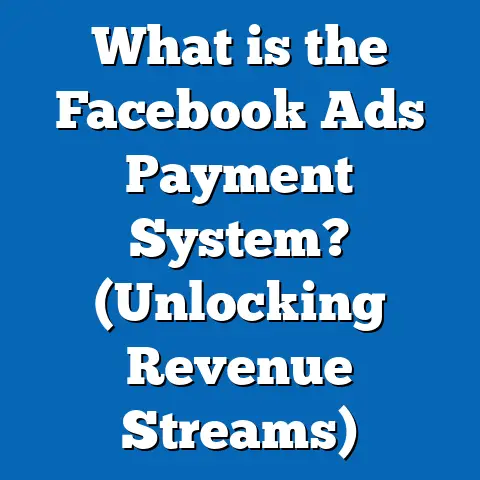What is a Facebook Ads Attribution Model? (Unlocking Success)
Introduction: Why Facebook Ads Attribution Model Matters for Your Marketing Success
In today’s highly competitive digital marketing landscape, businesses face the daunting task of understanding exactly how their advertising dollars translate into revenue. With customers interacting with brands across multiple devices, channels, and touchpoints—from social media feeds and search engines to email and offline interactions—it’s increasingly difficult to track which parts of your marketing strategy are driving meaningful results.
For brands leveraging Facebook Ads, one of the most powerful and widely used digital advertising platforms globally, this challenge is particularly relevant. Facebook’s complex ecosystem offers numerous ad formats, placements, and targeting options, creating multiple points where a potential customer may engage with your brand before converting.
This complexity makes it essential to understand which Facebook ads contribute to sales or conversions and how much credit each deserves. Without this clarity, marketers risk misallocating budgets, optimizing ineffective campaigns, or undervaluing key parts of the customer journey.
This guide will unpack everything you need to know about Facebook Ads Attribution Models—from basic definitions to advanced implementation strategies—so you can confidently optimize your Facebook advertising efforts and drive measurable business growth.
What Is a Facebook Ads Attribution Model?
Definition and Purpose
At its core, a Facebook Ads Attribution Model is a framework or set of rules that determines how credit for a conversion or sale is assigned to various Facebook ad interactions during the customer’s journey. Since users often see multiple ads before deciding to purchase or complete an action, attribution models help marketers understand which ads played a meaningful role.
Without attribution models, marketers might rely on simplistic metrics like last-click attribution—giving all credit to the last ad clicked before conversion. This approach ignores the broader customer journey and undervalues other impactful interactions.
Attribution models answer questions like:
- Did the user convert because of the first ad they saw or the last one they clicked?
- How much influence did retargeting ads have in closing the sale?
- Are awareness ads generating valuable interest even if they don’t directly lead to clicks?
By assigning credit accurately, these models allow marketers to:
- Allocate budgets efficiently across campaigns.
- Understand the real drivers behind conversions.
- Optimize creative and targeting strategies.
- Demonstrate ROI with confidence.
The Importance of Attribution in Modern Marketing
Specifically for Facebook Ads:
- Facebook’s extensive user data enables granular tracking of user behavior.
- Its diverse ad formats (video, carousel, lead forms) can influence different stages of the funnel.
- Cross-device usage (mobile, desktop) means attribution must consider multiple touchpoints.
Without accurate attribution:
- Marketers risk over-spending on “last-click” ads while neglecting awareness campaigns.
- Campaigns might be prematurely shut down due to misunderstood performance.
- Businesses lose insight into how upper funnel ads contribute to brand growth.
How Facebook Ads Attribution Works: Key Concepts
Touchpoints and Conversion Paths Explained
A touchpoint refers to any interaction a user has with your Facebook ad—this could be clicking on the ad, viewing it without clicking (impression), or engaging through likes/comments/shares that later lead to conversions.
A conversion path is the sequence of these touchpoints leading up to a conversion event. For example:
- A user sees an awareness video ad (view).
- Later clicks a carousel ad showcasing products.
- Finally clicks a retargeting offer and completes a purchase.
Facebook tracks these interactions within a designated attribution window to assign credit for conversions.
Understanding the Attribution Window
The attribution window defines how far back Facebook looks in time from the moment of conversion to attribute credit to ad interactions. It typically includes:
- Click-through window: The maximum number of days after clicking an ad that a conversion is attributed. Common defaults are 7 days or 28 days.
- View-through window: The time after viewing an ad (without clicking) within which a conversion can still be credited. Defaults are typically 1 day or 7 days.
Why does this matter?
If you set a very short window (e.g., 1-day click), you risk missing conversions influenced by earlier ads. A longer window gives a fuller picture but may dilute relevance.
Types of Attribution Models Available for Facebook Advertisers
Facebook offers several attribution models that marketers can select based on their campaign goals and sales cycle length:
| Attribution Model | Description | When Best Used |
|---|---|---|
| Last Click | Assigns 100% credit to the last clicked ad before conversion | Short sales cycles; direct response campaigns |
| First Click | Assigns 100% credit to the first clicked ad | Brand awareness; focus on initial interest |
| Linear | Splits credit equally among all clicked ads in conversion path | Balanced view; multi-touch journeys |
| Time Decay | Credits recent ads more heavily than earlier ones | Longer sales cycles; recent touchpoints have more influence |
| Position-Based (U-Shaped) | Gives 40% credit each to first and last clicks; remaining 20% split among middle touchpoints | Recognizes both introduction and closing stages |
In-Depth Analysis of Popular Facebook Ads Attribution Models
Last Click Attribution Model: Pros and Cons
How it works: This model attributes full credit for a conversion to the last ad clicked before the conversion event.
Example: If a customer clicks on three different Facebook ads over two weeks but purchases after clicking the last one, that final ad gets all credit.
Advantages:
- Simple and easy to understand.
- Works well when sales cycles are short or single interaction driven.
- Aligns with traditional digital analytics tools used by many businesses.
Drawbacks:
- Ignores upper funnel or early funnel ads that create awareness.
- Can undervalue retargeting efforts that nurture leads.
- May lead marketers to over-invest in bottom-of-funnel ads only.
First Click Attribution Model: When Awareness Counts
How it works: Assigns all conversion credit to the first clicked Facebook ad in the path.
Example: A user clicks an introductory video ad first but only converts after seeing multiple retargeting ads later; only the first ad receives credit.
Advantages:
- Highlights ads responsible for generating initial interest.
- Useful for measuring brand awareness campaigns.
Drawbacks:
- Neglects nurturing and closing touchpoints critical in long sales cycles.
- Can overvalue top-of-funnel ads when final purchase drivers differ.
Linear Attribution Model: Equal Credit for Every Step
How it works: Divides conversion credit equally among all clicked ads that contributed to the conversion.
Example: If a customer clicked three different ads before purchasing, each gets one-third credit.
Advantages:
- Fairly balances credit across all touchpoints.
- Supports campaigns with complex customer journeys.
- Encourages investment across funnel stages.
Drawbacks:
- May dilute credit from high-impact ads.
- Can be less actionable if many touchpoints exist per conversion.
Time Decay Attribution Model: Recent Interactions Matter More
How it works: Assigns exponentially more credit to interactions closer in time to conversion.
Example: Last clicked ad might get 40%, second last 30%, earlier ones smaller percentages.
Advantages:
- Reflects intuition that recent ads have stronger influence.
- Useful when user decision-making accelerates near conversion.
Drawbacks:
- Requires careful calibration of decay curve.
- Can underappreciate early awareness-building efforts.
Position-Based (U-Shaped) Model: Focus on Beginning and End
How it works: Gives 40% credit each to first and last click; remaining 20% divided among middle clicks.
Example: If four ads were clicked before purchase:
- 40% credit goes to first click
- 40% goes to last click
- 20% split among middle two clicks
Advantages:
- Balances importance of introducing brand and closing sale.
- Recognizes nurturing steps without overemphasizing them.
Drawbacks:
- Assumes beginning and end clicks are equally important (not always true).
Facebook’s Default Attribution Settings & Industry Impact
Historical Defaults and Shift After Privacy Updates
Facebook initially offered flexible attribution windows like:
- 28-day click + 1-day view
- 7-day click + 1-day view (most common default before 2021)
However, Apple’s iOS 14 privacy updates limited tracking capabilities for apps like Facebook by restricting access to user data unless explicitly allowed. This caused:
- Reduced granularity in attribution data.
- Shift towards shorter attribution windows (7-day click only became default).
- Increased use of aggregated event measurement instead of individual-level data.
Impact on Reporting & Optimization
Marketers noticed:
- Apparent drop in reported conversions due to stricter windows.
- Need for updated measurement strategies (Conversion API integration).
- Greater emphasis on multi-touch attribution for accuracy.
Real Data Insights: How Different Models Affect Performance Metrics
Industry-Wide Statistics on Attribution Impact
Recent surveys and reports reveal:
- AdEspresso’s 2023 Survey: 60% of marketers who switched from last-click attribution saw at least a 15% uplift in measured ROI because multi-touch models better captured the full customer journey.
- Facebook’s Internal Research: Advertisers using position-based or time-decay models reported up to 25% better campaign optimization efficiency compared to those relying solely on last-click data.
- Nielsen Study: Brands in retail and e-commerce sectors find linear and position-based models most reflective of consumer behavior patterns involving multiple touchpoints over days or weeks.
Case Study #1: E-Commerce Brand Grows ROAS by Switching Models
Client Background: An online fashion retailer running multiple campaigns across awareness, consideration, and retargeting stages on Facebook.
| Attribution Model | Return On Ad Spend (ROAS) | Cost Per Purchase | Key Insight |
|---|---|---|---|
| Last Click | 3.2x | $45 | Overlooked value of upper funnel ads |
| Linear | 4.5x | $38 | Balanced budget allocation improved ROI |
| Position-Based | 5.1x | $33 | Best representation of multi-touch impact |
By shifting budget based on position-based attribution insights, this brand increased total sales by 20% within three months while lowering costs per acquisition.
Case Study #2: SaaS Company Uses Time Decay for Long Sales Cycle Tracking
A B2B SaaS company running lead generation campaigns found that:
- Using last click undervalued early educational content ads.
- Time decay attribution gave more weight to nurturing emails and demos viewed closer to signup.
Result: Improved lead quality score by 18% after reallocation based on time decay attribution data.
Choosing the Right Facebook Ads Attribution Model for Your Business
Factors Influencing Your Choice
- Length of Sales Cycle
- Short cycles (<7 days): Last click often sufficient.
- Medium/long cycles (>7 days): Multi-touch models preferred.
- Customer Journey Complexity
- Simple paths benefit from last or first click.
- Complex journeys require linear or position-based models.
- Campaign Objectives
- Brand awareness: First click prioritization.
- Direct response/retargeting: Last click or time decay models.
- Data Privacy Constraints
- Limited data requires cautious interpretation; consider hybrid approaches.
- Available Tools & Integration
- Use Facebook Attribution tool or third-party software with customizable models.
Practical Tips for Selection
| Business Type | Recommended Model(s) | Rationale |
|---|---|---|
| E-commerce Retail | Position-Based or Linear | Multiple touchpoints from awareness to purchase |
| SaaS/B2B Companies | Time Decay | Longer decision-making cycles |
| Startups/New Brands | First Click | Focus on capturing initial interest |
| Direct Response | Last Click | Emphasis on immediate conversions |
Comparing Facebook Ads Attribution with Other Platforms
Understanding how Facebook compares with Google Ads, LinkedIn Ads, and others provides context for holistic marketing measurement.
| Feature | Facebook Ads | Google Ads | LinkedIn Ads |
|---|---|---|---|
| Default Attribution | Last click (7-day click) | Last-click; supports data-driven model | Last-click; limited multi-touch |
| Multi-Touch Support | Yes (various models) | Extensive (data-driven attribution) | Limited |
| Attribution Window | Configurable (1,7,28 days) | Flexible | Limited |
| Privacy Impact | Affected by iOS14+ | Less impacted | Less impacted |
| Cross-device Tracking | Supported | Supported | Limited |
| Integration | Deeply integrated with social ecosystem | Integrates with Google Analytics & Firebase | CRM integrations |
Facebook excels at social engagement data while Google captures strong search intent signals. Combining both can yield comprehensive insights across funnel stages.
Step-by-Step Guide: Implementing Facebook Ads Attribution Models Effectively
Step 1: Set Up Facebook Pixel Properly
Ensure you have installed and configured the Facebook Pixel correctly on your website or app. This tracks user actions such as page views, add-to-carts, purchases, etc., providing the foundation for accurate attribution.
Step 2: Enable Conversion API (CAPI)
Due to privacy changes (iOS14+), supplement pixel data with Conversion API which sends events directly from your server to Facebook for more reliable tracking.
Step 3: Choose Your Attribution Model in Facebook Ads Manager
Navigate to Ads Manager > Settings > Attribution Setting, then select your preferred attribution model and window (click/view).
Step 4: Analyze Conversion Paths Using Facebook Attribution Tool
Facebook’s standalone Attribution tool visualizes user journeys across multiple touchpoints including:
- Number of clicks/views per conversion
- Time between interactions
- Relative contribution of each ad
Use this data to identify which campaigns and creatives influence conversions most effectively.
Step 5: Adjust Budgets Based on Insights
Shift budgets toward campaigns driving incremental conversions as revealed by multi-touch models rather than last-click alone.
Step 6: Monitor & Test Regularly
Continuously test different attribution settings alongside campaign performance metrics. Revisit settings quarterly or when significant changes occur (e.g., new product launches).
Advanced Strategies for Maximizing Attribution Accuracy
Integrate Offline Conversion Data
For businesses with physical stores or offline sales processes:
- Upload offline transaction data back into Facebook.
- Connect CRM systems for full funnel tracking.
This bridges gaps between online ads and offline purchases ensuring holistic attribution.
Use Custom Attribution Models Where Possible
Some third-party platforms allow custom weighting based on your specific customer journey insights beyond Facebook’s default options.
Employ Machine Learning-Powered Data Driven Attribution (DDA)
Although still evolving on Facebook compared to Google Ads’ advanced DDA:
- Use predictive analytics tools that factor in complex variables influencing conversions.
This moves beyond static rules into dynamic attribution tailored per audience segment or campaign type.
Common Challenges in Facebook Ads Attribution & How To Solve Them
| Challenge | Solution |
|---|---|
| Data Loss Due To iOS14+ Privacy Restrictions | Implement Conversion API; use aggregated event measurement |
| Multiple Overlapping Touchpoints | Use multi-touch attribution instead of simplistic last-click |
| Misaligned Goals vs Chosen Attribution Model | Align model selection with specific campaign objectives |
| Cross-channel Interaction Blind Spots | Use cross-platform analytics tools integrating data from Google, CRM systems |
| Complex Customer Decision Paths | Visualize paths with Facebook’s path analysis; consider longer attribution windows |
Future Trends in Facebook Ads Attribution
Looking ahead, advertisers should watch for:
- Greater reliance on AI/ML: To predict which touchpoints truly influence conversions beyond simplistic rules.
- Enhanced privacy-compliant measurement: Aggregated Event Measurement will evolve further balancing privacy with accuracy.
- Cross-device & cross-platform integration: More unified views across mobile apps, web, offline stores expected.
- Shift toward default data-driven models: Similar to Google’s DDA becoming standard over rule-based models.
Staying informed will help marketers adapt quickly and maintain accurate measurement in changing environments.
Summary & Next Steps
Key Takeaways
- Facebook Ads Attribution Models define how credit is assigned for conversions across multiple ad interactions.
- Selecting the right model depends on sales cycle length, campaign goals, customer journey complexity, and data privacy context.
- Multi-touch models like linear or position-based generally provide more balanced insights than last-click alone.
- Privacy updates require adoption of new tracking technologies like Conversion API for continued accuracy.
- Regular review and testing of attribution strategies optimize budget allocation and campaign effectiveness.
Action Plan for Marketers & Business Owners
- Audit your current Facebook Ads tracking setup—pixel and CAPI implementation.
- Experiment with multi-touch attribution models that fit your business type.
- Use Facebook’s attribution reporting tools to visualize customer journeys.
- Adjust budgets based on comprehensive insights rather than last-click reports alone.
- Stay updated on industry changes around privacy laws and measurement technology.
- Consider complementing Facebook data with Google Analytics and CRM insights for cross-channel attribution clarity.
Unlocking success with Facebook Ads starts with understanding how your ads contribute value at each stage—not just what happens at final click. By mastering attribution models and harnessing data intelligently, you’ll make smarter decisions that grow your business sustainably over time.






